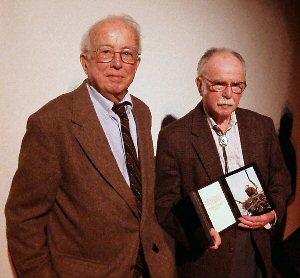The Origins of the Friends of Dyke Marsh
The Friends of Dyke Marsh was formed in 1975 and incorporated in 1976. Since then, the group has grown and become more active in our work to protect the health of the Dyke Marsh Wildlife Preserve and to restore it.
In the following article, one of FODM's founding members, the late Ed Risley, describes how and why the Friends of Dyke Marsh was formed.
The Friends of Dyke Marsh: Over Three Decades
 Founding members and past FODM Presidents Ed Risley and Jeb Byrne. Photo by Ed Eder. -- by Ed Risley (Founding Member, FODM)
Founding members and past FODM Presidents Ed Risley and Jeb Byrne. Photo by Ed Eder. -- by Ed Risley (Founding Member, FODM)
The origins of the Friends of Dyke Marsh, Inc. can be stated quite precisely: it followed a meeting of local activists and naturalists held with officials of the National Park Service on January 28, 1976. Of course there had been earlier "friends," notably Louis Halle, whose splendid book Spring in Washington (1945) was set in large part in Dyke Marsh; Irston Barnes whose articles in the Washington Post helped engineer the Act of Congress of 1969 which set aside the Marsh as a wildlife preserve; and Jackson Abbott who for years had been keeping records of sightings and leading bird walks. Nonetheless, by 1976 the area seemed virtually abandoned. No attempt will be made here to identify the numerous volunteers who gave their time and skill freely over the past three decades to preserve the Marsh.
The appearance of U.S. Army Corps of Engineers staff in the Marsh in late 1975 raised questions which the Park Service proposed be addressed at a meeting which was organized by the Audubon Naturalist Society (ANS). I was on the ANS Conservation Committee and put together a list of attendees. In addition to publicizing possible plans for expanding the Marsh, it was agreed that an environmental assessment would be prepared and that the public should be involved through a continuing committee (the Friends!). In short order officers were elected and a charter was adopted. Later, articles of corporation were adopted and Friends' objectives were agreed to. Above all, the goal of the Friends was to preserve the remnant but valuable fresh water tidal marsh against a multitude of human and natural threats.
A number of steps were agreed to, first by the new committee and in the years since:
- To promote awareness, regular meetings were set up (now on a quarterly basis at Huntley Meadows Park Visitors Center) open to the public. Speakers on topics generally related to the Marsh were recruited.
- A newsletter was published, at first sporadically and later on a quarterly basis. To maintain visibility and credibility members wrote letters to editors and contributed to periodicals such as Audubon and the Washington Post. A large aerial photo was purchased and made part of a traveling exhibit. Brochures and bird lists were produced and distributed.
- Relations with the Federal managers were strengthened. The Corps of Engineers backed off and the impact statement abandoned, but relations with the Park Service were strengthened although every few years there would be a new set of officials to deal with. In 2000 the Friends were formally recognized as a collaborating partner of the National Park Service. Our contribution was to participate in regular Marsh cleanups and to host and guide school groups and other visitors. Periodic meetings are held with the Superintendent to discuss issues and problems.
As the area around Dyke Marsh has become urbanized various human problems have been aggravated. Some problems such as hunters, commercial fishing, drug use and public immodesty were clearly illegal and gradually reduced. FODM has over the years engaged in a variety of issues, including application of herbicides in the marsh, impact on the marsh of Belle Haven Marina, the construction of the new Wilson Bridge and National Harbor. Such activities continue. FODM has also worked with the National Park Service on a boardwalk for Dyke Marsh, and after its destruction by Hurricane Isabel, now a new one.
A major positive activity of the Friends has been collecting and organizing data of all elements of the natural environment. Over $30,000 has been collected and spent to gain Dyke Marsh entry in the Virginia State Department of Natural Resources files and to collect data on, especially, the bird life including annual winter census and breeding bird surveys. Collection of data also includes results of the weekly bird walks led by expert birders. Other flora and fauna are the subject of ongoing collection efforts which we support and already have published in a pamphlet prepared by a trained biologist.
After three decades, members can look back with satisfaction on the camaraderie of regular meetings, the contribution of volunteer work and the gains in understanding the natural ecology at their doorstep. It is clear that threats to the integrity of Dyke Marsh will never cease. Buffeted by natural and manmade forces, the continuation of the Friends is essential.

 Friends of Dyke Marsh, Inc. is a non-profit 501(c)(3) organization.
Friends of Dyke Marsh, Inc. is a non-profit 501(c)(3) organization.